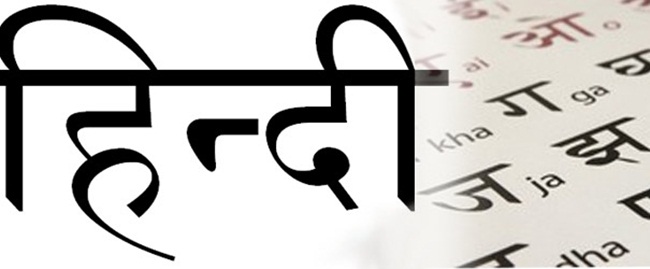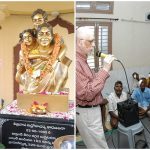Today is Hindi Day in India. The country celebrates Hindi as the official language of the Indian Union on September 14 every year. September 14 is the day when the Constituent Assembly declared Hindi as the official language for the Union of India in 1949. Hindi is often mistaken to be the national language of India. However, it was initially the official language of only nine Indian states and five union territories including Delhi. Recently, Prime Minister Narendra Modi invoked the countrymen to enrich and preserve Hindi and other Indian languages, on the inaugural day of the World Hindi Conference in Bhopal, the capital of Madhya Pradesh.

We at Indian Eagle celebrate the Hindi Day and share some interesting facts about Hindi language:
In 1950, there was a constitutional change in the recognition of Hindi language. The Constitution of India recognized Hindi in the Devanagari script as the official language of the country. The educated class of the then society used to prefer English as a language of official communication even after independence of India. English was to be prohibited 15 years after the Constitution of India was formed on January 26, 1950. But the non-Hindi speaking population of South India, whose mother tongues are hardly similar to Hindi, opposed the proposal to ban the use of English. It forced the Parliament to bring into effect the Official Languages Act 1963, which recognized English as an official language of India. Today, English is the official language of Nagaland and Arunachal Pradesh in Northeast India.
Bihar was the first state of British India to have adopted Hindi as its sole official language and replacement of Urdu in the year 1881.
Today, about 40% of the total Indian population speaks Hindi in day-to-day life. Hindi is also spoken in a few foreign countries such as South Africa, Mauritius, New Zealand, Surinam, Fiji, Nepal, and Trinidad and Tobago.
180 million people are proud of Hindi as their mother tongue. It is the second language for almost 300 million people across the globe.
Hindi is often referred to as the “Language of Unity’ because of its wide use by the freedom fighters of India during the British Raj. Mahatma Gandhi, an eminent political figure and freedom fighter, encouraged the use of Hindi as the language of communication, the language of protest and the language of the nation’s collective voice.
The Oxford Dictionary has incorporated the Hindi word “Swadeshi”, which is a matter of pride for the Hindi-speaking Indians and the descendants of the freedom fighters who used the word “Swadeshi” as a sign of patriotism. Besides this, many Hindi words such as ‘Guru’, ‘Nirvana’, ‘Adda’, etc. are used in many parts of the world.
Hindi is mostly influenced by Sanskrit language, which dates back to nearly 5,000 BC. It owes its origin to the Indo-Aryan branch of the Indo-European language group. The word “Hindi” came from the Persian word “Hind”, which means the “Land of the Indus River.” The river falls into Pakistan after passing through Tibet and northernmost part of India.
Hindi was called different names at different stages of its evolution in different eras. Hindi was known as Apabhramsa at its earliest stage. Kalidas, a renowned Sanskrit scholar and literary playwright in ancient India, composed a romantic play titled “Vikramorvashiyam” in Apabhramsa in 400 AD.
There are no articles in Hindi language as English has three articles: a, an, and the. One of the most interesting facts about Hindi is that every noun has its own gender, either masculine or feminine. Adjective and verb forms of a noun change according to the gender of the noun. That’s why learning Hindi language and grammar is a difficult task. On the other hand, Hindi is one of the easiest languages to read because words are pronounced as exactly as they are written.
Hindi language has borrowed many words from Arabic and Persian languages. The Mughals enriched the Hindi vocabulary with many Urdu words. Hindi was immensely influenced and modified by the Mughals. However, Hindi is the youngest of all Indian languages.
Hindi is also referred to as a link language as it has interconnected non-resident Indians living around the world. It is the fourth most popular language following Chinese, Spanish and English on the list of ten most widely spoken languages in the world.
George Bush, former President of the USA, had allocated a budget of $114 million to teaching of Hindi as a part of the curriculum from the kindergarten to the graduate level, considering the importance of Hindi as a common native language of Indian Americans during his tenure.
Hindi has found acceptance among South Indians of the present generation. Previously, Hindi was not welcome in this part of the country. Deve Gowda, former Chief Minister of Karnataka, spoke up in support of Hindi language in 1997. Later, former CM of Tamil Nadu, Karunanidhi, recited a Hindi poem during a socio-political campaign. Even current CM of Tamil Nadu, Jayalalitha speaks in Hindi to reach out to the mass during campaigns.
A few other interesting facts about Hindi:
- “Udanta Martanda” was the first Hindi weekly from Calcutta (now Kolkata) in 1826
- Gujarati poem Narmad proposed Hindi as the national language of India in the 1850s
- The term ‘Hindi’ was used for what is known as Urdu today till 1850
- “Samachar Sudhavarshan” was the first Hindi daily from Calcutta in 1854
- The “Bharatendu” period of modern Hindi literature began in 1886
- Raja Harishchandra, the first Hindi movie by Dadasaheb Phalke, was released in 1913
- Alam Ara, the first Hindi talkie in Indian Cinema, was released in 1931
- Hindi typewriters came to markets in the 1930s
Indian Eagle celebrates all important days of India in the USA, connecting Indian Americans with their respective native cultures. Indian Eagle books cheap air tickets to India for them, without compromising the quality of service. Search. Book. Fly.
Interesting Stories of India:
- Interesting Facts about Sanskrit
- Interesting Facts about Delhi’s Hidden Heritage
- Interesting Facts about Meera Bai
- Interesting Facts about Lucknow City
- Interesting Facts about Rath Yatra Festival
- Interesting Facts about Kolkata Tram







